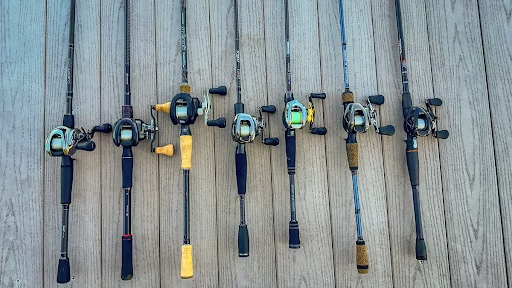Having a big fish on the line triggers thrill unlike any other, but the right fishing rod should always be in hand to carry on the excitement.
Targeting big fish is beyond just having patience and luck-an incapable gear will not meet the challenge posed by the fish. Choosing the fishing rod for big fish is a very serious decision.
In the sea of rods all promising strength, flexibility, or distance, how could one even decide? Let’s get it down in straight fishing terms as much as possible without going into all that tech.
Scenario 1: You’ve Hooked a Big One, and the Rod’s Not Helping
While on the bank, your fish runs hard on the bending rod. You try to control the fight. The fish dives and snaps the line; power mismatch was the problem.
In going for bigger species, your rod should be able to take the pressure and respond to it with counter-pressure. In comes the Power of the rod, which is measured as light, medium, or heavy, and does so in terms of how much pressure it takes to bend the rod.
For greater species like salmon, carp, or musky, consider medium-heavy rods.
For saltwater catches such as tuna or kingfish, heavy or extra-heavy rods are preferred.
Think power is a rod’s “muscle,” and without power, big fish will win every single time.
Scenario 2: You Are Losing Out on Casting Distance
You are surfcasting or fishing on rocks and trying to reach deeper water. This would generally speak to a rod length issue.
Rod length determines the distance and accuracy of the cast. Wide-open spaces for anglers’ big fish should consider longer rods, which can be anywhere from 8 feet to 10 feet, for better reach. However, when you go offshore fishing or in tighter spaces, the shorter rod of 6 feet to 7 feet would provide you with better control.
Your environment should set up the level for length:
Longer = better casting distance + shock absorption
Shorter = leverage + control during the fight
Scenario 3: Hookset Is Too Slow or Too Hard
In a scenario where you could receive a bite but hooksets just were not landing. Maybe you are not at fault, but the action might be.
Action describes where the rod bends:
Fast action rods will bend near the tip—great for fast hooksets and sensitivity movements.
Moderate and slow action rods will bend somewhere along the rod all the way nearer to the base, which is useful during prolonged fights.
Fast action rods when used are great when pursuing aggressive fish that attack hard. Slow-action rods provide a lot of give and are gentle on lighter lines, but for big fish, you’d want that fast action most of the time.
Scenario 4: Gear Fatigue and Travel Headaches
Bulky gear can be a burden while traveling, especially for an angler on the go. But then again, you need not give up on performance. These days multi-piece and telescopic fishing rods can handle bigger-than-life fights, great for the angler on the move after big catches without lugging a full-sized rod bag through airports or down trails.
Make sure that quality is solid through and through go carbon or graphite composites with strong connection points.
The Other Details to Consider
- Line & Lure Ratings: Always choose rods that will satisfy the gear you want to use. Rods designed for heavy line (20-50 lb test) and large lures are intended for tackling tough fish.
- Trigger & Handle: A good grip gives great control and is less draining through an ongoing battle. EVA foam and cork are popular for some good reasons.
- Reel Moderate: For the sake of equity, allow the rod to complement your best-reel choice: spinning or baitcasting.
The Verdict: Confidence in Every Cast
It need not be complicated to go ahead and choose the perfect casting rod for big fish. Begin by considering the conditions under which you will go fishing, your target species, and your style. Once you have matched those with power, length, and action of a rod, half the work is done.
Because when the big bite hits, you want to battle with confidence—not with equipment that buckles under pressure.







